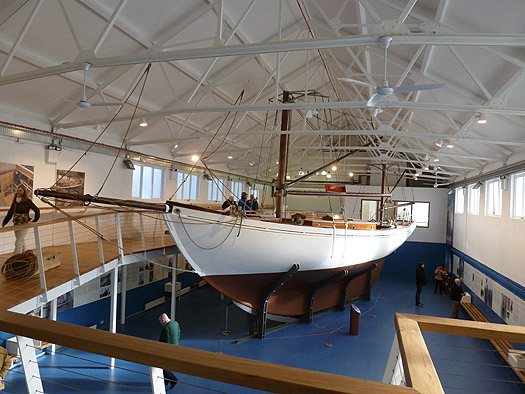#isaf – Kites or sailboards to be highlighted the most exciting form of sailing in the 2016 Olympics? If you're waiting for a clearcut answer from the continuing deliberations of the International Sailing Federation currently under way at their Annual Conference in Dun Laoghaire, then don't hold your breath.
Of all the world's capital cities, it is Dublin which is probably most aware of the growing impact of windsurfing and kite-surfing as hugely accessible forms of sailing which can take place off any beach. The greater city area is so well-endowed with miles of sand which can provide world class sport when the wind is up that, like it or not, we ordinary Dublin beach-walkers have become connoisseurs of the kiting versus sailboards controversy.
So although it may have discomfited many traditionally-minded national sailing establishments when sail-boarding became an Olympic sport, we Dubs were ahead of the posse. We were already looking to the next move. For we knew that, when surrounded by kitesurfers at choice venues like Dollymount Strand, sailboarders can seem like dowagers at a disco.
Thus with world sailing's sometimes embarrassing desire to appear hip, it was no surprise back in May when it was announced that, albeit by the narrowest of voting margins, kite-surfing would replace windsurfing at Rio in 2016. But while it may have been a definite decision, seems it wasn't a binding one. As far as we can gather, the relevant section of the current conference (which has 700 delegates in all) have changed their mind on the kiteboard/sailboard Olympic thing. Well, sort of.
Admittedly, we'd been looking forward to using a headline which leaps from the page, and would have become part of international sailing history. "The Dublin Decision" would certainly have wings. But we're currently looking at "The Irish Indecision". Or more accurately, "The Continental Compromise". Thanks to notable eloquence from the Continent in the form of delegates from Spain and Eastern Europe, we've ended up with a compromise which, at the time of writing, will see both windsurfing and kite-surfing at Rio, but put together in some mixture which won't involved an increase in sailing's Olympic medal allocation, which is always under scrutiny.
For that of course is the nub of the matter – the place of sailing in the Olympics. It's not an arena activity, and it's definitely a vehicle sport – that's two negatives. It could be that in the future, only the most minimal sailing vehicles will be accepted as sufficiently athletic for Olympic inclusion. Maybe some time we'll look back fondly to the days when boats were used in the Olympics, as kitesurfing in all its forms becomes the only Olympic sailing category.
Meanwhile, the Dun Laoghaire deliberations have been good for Ireland in that outgoing ISAF President Goran Petersson was lavish in his praise for the superb style of Dun Laoghaire's organisaton of the International Youth Worlds in July. But there was a poignant moment for the Irish sailing community at the World Sailors of the Year Awards at the Mansion House on Tuesday night.
Multiple Olympic Gold Medallist Ben Ainslie of Britain took the men's award, so no surprise there. But history was made with the Women's Award going to Lijia Xu of China for her Gold Medal in the Olympic Laser Radials. At the beginning of the sailing Olympics, she was scarcely figuring in the results at all, while Ireland's Annalise Murphy was piling on a substantial overall lead. But the Chinese sailor just got better and better, and was ahead when it mattered – at the finish of the last race. It was a mind-blowing lesson in sports psychology.
PETE HOGAN'S LOVELY BOOK
Much time may have passed since he did it, but nothing will ever change the fact that sailor/artist Pete Hogan of Dublin was the first Irishman to round Cape Horn single-handed, sailing his gallant little Tahiti ketch Molly B. He wrote about it at the time, but now with the mellowing of the years, he has written and illustrated a lovely book, The Log of the Molly B, which is being launched next Wednesday (November 14th) in the Davenport Hotel in Dublin's Merrion Street at 6.0pm by Conor Brady, former editor of The Irish Times.
There's an open invitation to the launching for the entire sailing community, and any other well-wishers too, for that matter. Of course there is an expectation that you'll feel moved to buy the book. But that's no hardship – it's a real page turner, a joy to have and to hold and to read, beautifully produced by Liffey Press, and at €19.95 it's priced just right.
There is of course much more to it than the rounding of the Horn. The Log of the Molly B perfectly evokes the mood of the 1980s, and an approach to seafaring and ocean wandering which harked back to the era of the great individualists and legends of the sea, rather than being overpowered by the shiny new era of advanced marine electronics and high tech sails and rig, set in a framework dominated by official safety requirements.
So if you're in the mood to savour the atmosphere of a gaff rig gathering and celebrate the true spirit of voyaging, the Davenport next Wednesday at 6.0 pm is the place to be.

Creatures of the deep – a giant manta ray take flight past Pete Hogan's ketch Molly B, one of his many attractive illustrations for his new book "The Log of the Molly B".
THE JOY OF WORK (when others are doing it)
It was intriguing to note that one of the most popular features at the recent Hamburg Boat Show was a special active exhibition where damaged or worn glassfibre boats were given the complete restoration treatment during the course of the show.
It all sounds rather un-Germanic - you'd think their attitude would be that such things should be done by professionals behind closed doors. And heaven only knows what the front-line exhibitors showing shiny new boats made of the fact that so much attention was being given to scruffy old ones. But it was a runaway success, the DIY brigade loved it and learned much from it, and of course for the ordinary Joes and Josephines who wouldn't dream of doing their own maintenance and repair tasks, there was the eternal fascination of watching work in progress.
Those of us who were lucky enough to be allowed in to the workshop at Collins Barracks when John Kearon and his team were conserving Asgard could only reflect that it was a pity that when the historic old ketch was finally put on display, it would be as a static exhibit. In many ways it was more interesting when the work was in progress, not least when the team of voluntary riggers from Howth, led by Pat Murphy and Neville Maguire, were on the job to provide enough in the way of spars and rigging to give a better impression of what Asgard was like in her heyday.
However, the work has been so well done that even with the old girl now totally at rest and on display, it's a very complete exhibition, encompassing the development of yacht design and building with an insight into a very complex period in Irish history.
With a well-chosen selection of photos, the human interest shines through in unexpected ways. We already knew that Erskine Childers' friend and shipmate, Gordon Shephard, had an easygoing approach to life despite twice being the recipient of the Royal Crusing Club's Chakenge Cup, the world's senior voyaging award. He won it in 1911 and again in 1913, the latter year as skipper of Asgard on a late Autumn voyage from Norway to North Wales, going west of Scotland.
In the Great War, immediately after the gun-running of 1914, he became the youngest Brigadier, on active service with the Royal Flying Corps. He did not survive the war. Yet up in Collins Barracks, he is forever alive, aboard Asgard as she sails along in July 1914 laden to the deckbeams with vintage guns, photographed at the helm wearing what look like an old and not at all stylish cardigan, the very essence of the happy-go-lucky cruising man.

The conserved Asgard on display in the museum at Collins Barracks. The exhibition provides a valuable insight into the cruising yachts of her era, and the human story of those involved in a complex historical episode. Photo: W M Nixon






























































